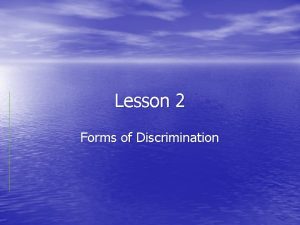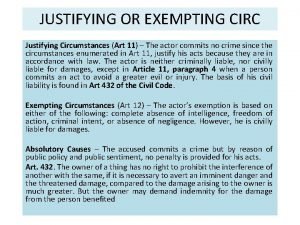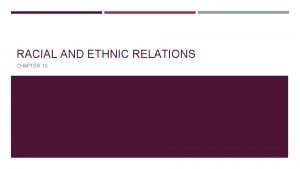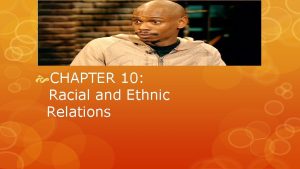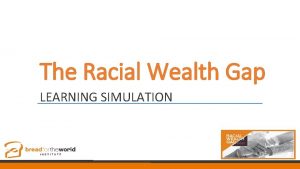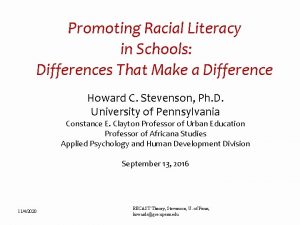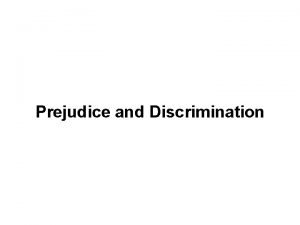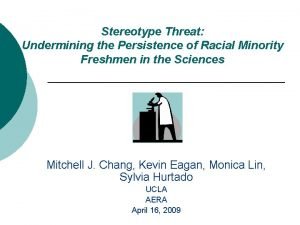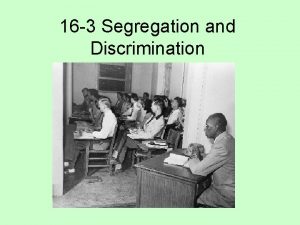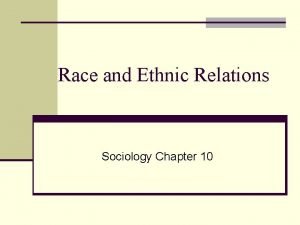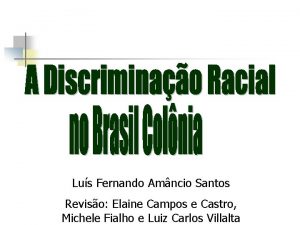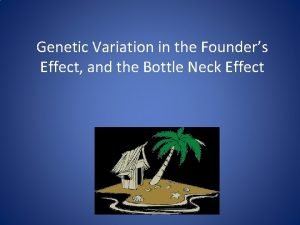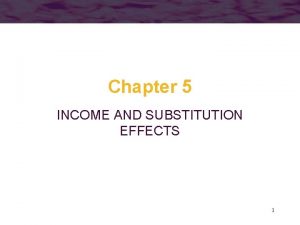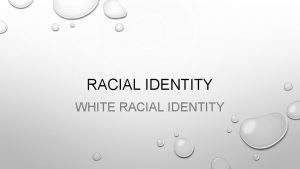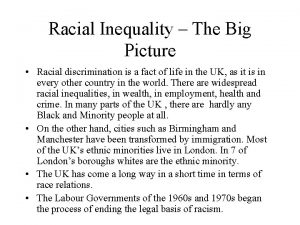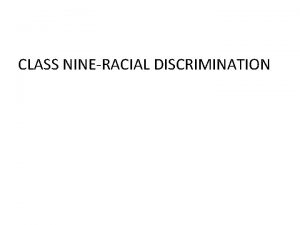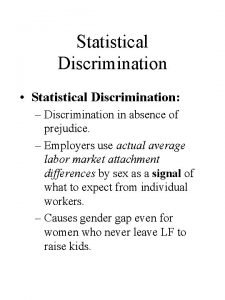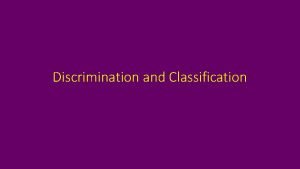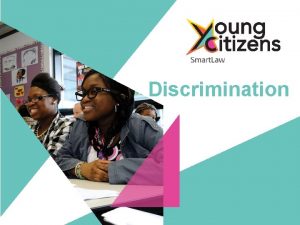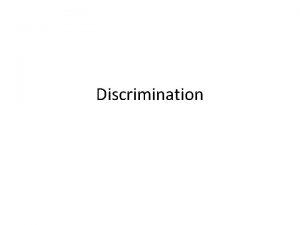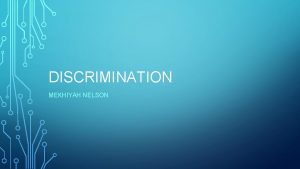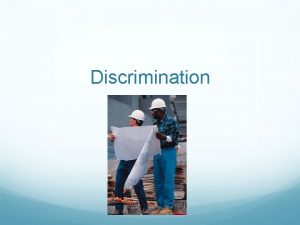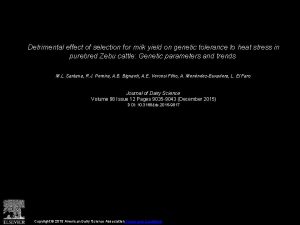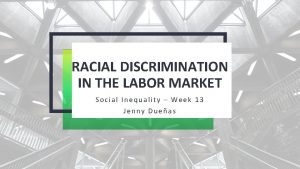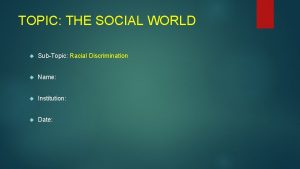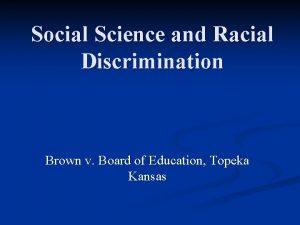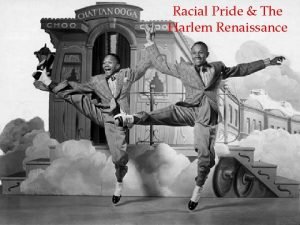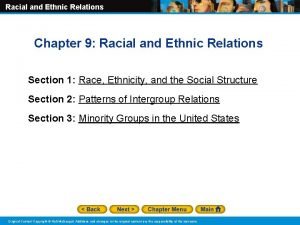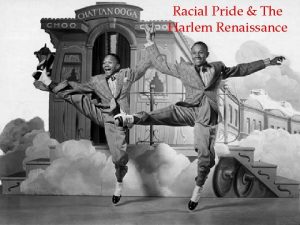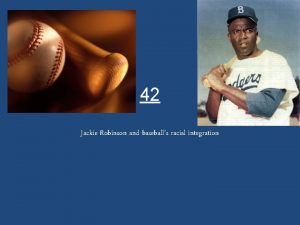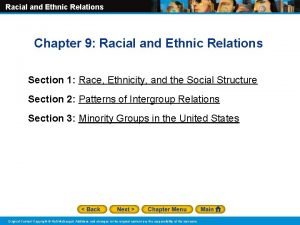Mitigating the Detrimental Effect of Racial Discrimination Social
































- Slides: 32

Mitigating the Detrimental Effect of Racial Discrimination: Social Support, Ethnic Identity & Racial/Ethnic Socialization in the Family November 13, 2018 Michael M. Davis Lecture Series The Center for Health Administration Studies (CHAS), UChicago Yoonsun Choi, Ph. D. , Associate Professor & Michael Park, Ph. D. Candidate, School of Social Service Administration, UChicago The study is supported by the Eunice Kennedy Shriver National Institute of Child Health & Human Development (NICHD, R 01 HD 073200).

Asian American Paradox • Youth outcomes tend to co-occur. – Antisocial behaviors are positively correlated with mental distress, which also increases substance use. Youth mental distress are often expressed in acting out behaviors. • The developmental outcomes of Asian Americans are mixed with less externalizing problems (e. g. , substance uses, antisocial behaviors), good grades, but high internalizing problems (e. g. , mental distress).

Why? • Factors derived from race/ethnicity, culture and immigration may explain the paradox. • That is, the experience of growing up in an immigrant family & as a racial/ethnic minority may be related to the paradox. – Explicit and blatant racism triggers anger but implicit & structural racism produces mental distress. – The negative impact of racial discrimination is lasting.

Divided Socio-Political Climate • Race and immigration are at the center of politics today. • Surge in overt racism – Dramatic increase in hate crimes – White nationalism: From fringe to the center stage – Hostility, fear-mongering and xenophobia • Overt/covert legislative and judicial racism – Many thought that it is post-racial society. • Structural, implicit racism continues. – In fact, due to blatant and overt racism, structural & implicit racism are overlooked or downplayed.

Evidence of Perpetual Racism • Exacerbating social, economic & political inequality by race/ethnicity – Income gap is the largest among Asian Americans. • Continued disparity in health, mental health and educational gaps among children • Disproportionate representation of Black and Latinx in the justice system • Asian Americans remain invisible: “Asians don’t count. ” – Filipino Americans: The invisible among the invisible • Espenshade & Radford (2009) “No longer separate, not yet equal”

Unique Positionality of Asian American • “Model Minority” & “Honorary Whites” – Problem free, hard working, self-care – This seemingly positive stereotype is coupled with negative ones. • “Perpetual Foreigner” – Regarded as a foreigner regardless of nativity and generation • “Caught in the Middle” – Middle-man minority theory (Min, 1996), racial triangulation theory (C. J. Kim, 1999) – Asian American youth report the highest rate of peer harassment, racial discrimination by both majority and other minority youth.

Mitigating the Detrimental Effect • Social support – Instrumental and emotional support – From family, peers, schools and community • Racial/ethnic socialization in the family – With a goal of strengthening ethnic identity/pride – Cultural socialization, promotion of mistrust & preparation of bias – Experience of racial discrimination influences racial/ethnic socialization in the family.

Filipino- vs. Korean Americans • Mixed pattern of acculturation among parents – Either end of acculturation spectrum among parents: English speaking, most acculturated Filipino parents (in regard to occupation, residential and ethnic identity) vs. limited-English speaking, least acculturated (almost separated) Korean parents – However, Filipino families uphold traditional familism and other traditional family values more so than Korean families (e. g. , family obligation, gendered norms) (Choi et al. , 2017). • Youth show more similarity than the parent generation. (Choi et al. , 2018; under review) – Growing up Asian Americans with bicultural identity – Divergent and convergent developmental outcomes

Midwest Longitudinal Study of Asian American Families (ML-SAAF) • Midwest families with an adolescent child ages between 12 and 17 in 2014, whose mother is of Filipino and Korean heritage • Wave 1 in 2014 -2015: N=1, 580: 379 Filipino American youth & 377 parents (365 dyads), 410 Korean American youth and 414 parents (407 dyads), Wave 2 in 2016 (76% retention), Wave 3 in 2018 (86% of Wave 1 retention). • In Wave 1, in-person interview (84%) by bilingual interviewers; multilingual survey available but 8% of youth used heritage language versions. Selfadmin in later waves.

Samples • Mean ages: 15. 28 (SD=1. 89) for FA, 14. 76 (SD=1. 91) for KA youth • About equal gender distribution in both groups • 71% FA and 58. 29% KA U. S. -born • Among foreign-born, average years of living in U. S. were 8. 47 (SD=4. 24) for FA, 8. 13 (SD=4. 28) for KA • Parent Participants: – Primary caretakers were mothers (92. 02% FA, 95. 65% KA), foreign-born (90. 43% FA, 98. 55% KA), living in US on average for 21. 38 years (SD=11. 01) for FA, 16. 04 years (SD=8. 53) for KA, college educated (88. 56% FA, 83. 09% KA), married (88. 56% FA, 92. 03% KA) and employed (87. 23% FA, 64. 69% KA mothers)

Two Sets of Analyses • How different types of social support (i. e. , emotional and instrumental) moderate the negative impact of perceived racial discrimination on Asian American youth development • Mediating process of racial/ethnic socialization between the experience of racial discrimination and bicultural identities among Asian American youth

Study 1: Moderation by Social Support • Authors: Park, M. , Choi, Y. , Henly, J. & Noh, S. • Examines (1) the relationship between racial discrimination and youth developmental outcomes (GPA and depressive symptoms), (2) whether the relationship is moderated by two distinct types of social support and (3) whether the moderating effect vary by nativity (a place of birth)

Social support • Social support refers to a broad range of resources that are transferred across social relationships (Thoits, 2011). • Empirical evidence shows that social support can enhance, directly or by buffering, youth development.

Types of Social support • Emotional support may be sought by distressed individuals to cope with negative feelings. • Instrumental support may be sought by individuals in need of tangible assistance (such as financial support) with a stressful situation.

Moderating Effects • Problem-focused coping vs. emotion-focused coping (Lazarus & Folkman, 1984) – Coping research has shown that problem-focused coping was generally more adaptive, while emotion-focused coping is more likely to be maladaptive on an array of outcomes. • This may be more complex than we think (Lazarus & Folkman, 1988). – The stress-alleviating effect of problem-focused coping was amplified among the more acculturated (Noh and Kaspar, 2003). – Emotion-based coping had a stress-alleviating effect among individuals with high support from co-ethnic group.

Gaps in Literature • The expansive social support literature has largely neglected Asian American youth. • Limited investigation on differential roles of emotional and instrumental support in stressmoderating relationships • Limited attention on whether and how nativity status may shape the operation of social support as a coping resource.

Analyses • • Youth outcomes: Depressive symptoms and GPA Adversity: Perceived racial discrimination Social support: Emotional vs. instrumental Concurrent, longitudinal models – Concurrent: W 1 predictors regressed on W 1 outcomes – Longitudinal: W 1 predictors regressed on W 2 outcomes – Longitudinal accounting for prior outcome: W 1 predictors + W 1 outcomes regressed on W 2 outcomes

Hierarchical Regression • Step 1 [Demographics (Ethnicity, nativity, gender, household income, age) + racial discrimination + emotional support + instrumental support] • Step 2 (Model 1 + Racial discrimination X two types of social support) • Step 3 (Model 2 + Racial discrimination X two types of social support X nativity)

Hierarchical Regression (Main Effects)

Hierarchical Regression (Interactions)

Results (Main Effects) • Racial discrimination predicts more depressive symptoms and lower GPA. – The negative impact is most evident on mental health, both concurrent and longitudinal. The impact remains after accounting for prior level of depressive symptoms. – Its impact is significant and concurrent on GPA. • Emotional and instrumental support reduces youth depressive symptoms, concurrently and/or longitudinally.

Results (Two-way Interactions) • The impact and direction of emotional and instrumental support vary by the level of racial discrimination. – Emotional support worsens the relationship between racial discrimination and depressive symptoms but instrumental support mitigates it. – Instrumental support alleviates the impact of racial discrimination on GPA. Emotional support did not show a significant buffering impact on GPA.

Results (Three-way Interactions) • Emotional support mitigates the negative impact of racial discrimination on GPA among foreign-born youth. • Instrumental support mitigates the negative impact of racial discrimination on GPA among U. S. -born youth

Results (Three-way Interaction) Emotional Support & GPA 3. 55 3. 5 (1) High emotional support, U. S. born 3. 45 (2) High emotional support, foreign born GPA 3. 4 (3) Low emotional support, U. S. born 3. 35 3. 3 (4) Low emotional support, foreign born 3. 25 3. 2 3. 15 3. 1 Low Discrimination High Discrimination

Results (Three-way Interaction) Instrumental Support & GPA 3. 6 3. 5 (1) High instrumental support, U. S. born GPA 3. 4 (2) High instrumental support, foreign born 3. 3 (3) Low instrumental support, U. S. born 3. 2 (4) Low instrumental support, foreign born 3. 1 3 Low Discrimination High Discrimination

Results (Three-way Interactions)

Highlights/Implications • Persistent & negative impact of perceived racial discrimination on youth development, especially on mental health • Social support is not universally positive but, rather, conditional depending on the types of social support and outcome. • Potential subgroup difference by nativity. • Additional analyses are being conducted by gender and ethnicity.

Study 2: Mediation of Racial/ethnic Socialization in the Family • Authors: Woo, B. , Maglalang, D. D. , Ko, S. , Choi, Y. , Park, M. , Takeuchi, D. • Examines the mechanisms in which the experience of racial discrimination influences racial/ethnic socialization in the family, which may facilitate/hinder the development of bicultural identities • SEM analyses using the bootstrapping and ML with missing values approach • Wave 1 independent and mediating variables predicting Wave 2 youth bicultural identity; By ethnic groups

Filipino Model Youth • Promotion of mistrust • Preparation of bias + + Youth R/E discrimination Youth Ethnic Identity - + + • Parental Promotion of mistrust + Parental R/E discrimination + + • Preparation of bias • Concern about children’s minority status Covariates: wave 1 youth ethnic & American identity wave 1 parental ethnic & American identity youth sex and age, parental SES Youth American Identity Chi 2 (55)=64. 308, p>. 05; RMSEA=0. 021; CFI=0. 980

Korean Model Youth • Promotion of mistrust • Preparation of bias + + Youth R/E discrimination + + + Parental R/E discrimination Youth Ethnic Identity + Parental • Promotion of mistrust • Preparation of bias • Concern about children’s minority status Youth American Identity + Covariates: wave 1 youth ethnic & American identity wave 1 parental ethnic & American identity youth sex and age, parental SES Chi 2 (55)=56. 159, p>. 05; RMSEA=0. 007; CFI=0. 997

Results • Experiences of racial discrimination are fully mediated by racial/ethnic socialization. – Racial discrimination in Wave 1 did not predict bicultural identity in Wave 2 but was associated with racial/ethnic socialization in the family, which in turn longitudinally influenced ethnic identity (not American identity). • Subgroup differences – Racial discrimination was mediated, by increasing promotion of mistrust and concerns about minority status among Filipino families and increasing preparation for bias among Korean families.

Highlights/Implications • When parents experience racial discrimination, it reinforces a racial/ethnic socialization in the family. • However, the ways in which racial/ethnic socialization longitudinally influences ethnic identity vary across the subgroups. • Promotion of mistrust, relative to preparation for bias or increased concern about children’s minority status, may in fact weaken ethnic identity.
 Don tiburcio symbolism
Don tiburcio symbolism Lesson 2 racial discrimination
Lesson 2 racial discrimination Examples of mitigating factors
Examples of mitigating factors Shipboard oil pollution emergency plan
Shipboard oil pollution emergency plan Article 11 justifying circumstances
Article 11 justifying circumstances Chapter 4 vulnerability assessment and mitigating attacks
Chapter 4 vulnerability assessment and mitigating attacks Jim crow laws in what region or regions did it exist
Jim crow laws in what region or regions did it exist Chapter 10 racial and ethnic relations
Chapter 10 racial and ethnic relations Chapter 10 racial and ethnic relations
Chapter 10 racial and ethnic relations Black studies and the racial mountain
Black studies and the racial mountain Racial wealth gap simulation
Racial wealth gap simulation Promoting racial literacy in schools
Promoting racial literacy in schools William jennings bryan apush
William jennings bryan apush Racial prejudice
Racial prejudice Racial insults
Racial insults In what region did racial etiquette exist
In what region did racial etiquette exist Cartel ley organica contra la discriminacion racial
Cartel ley organica contra la discriminacion racial Chapter 10 racial and ethnic relations review worksheet
Chapter 10 racial and ethnic relations review worksheet Democracia racial
Democracia racial Social thinking social influence social relations
Social thinking social influence social relations Social thinking social influence social relations
Social thinking social influence social relations Bohr effect and haldane effect
Bohr effect and haldane effect Founder effect vs bottleneck effect
Founder effect vs bottleneck effect Income effect graph
Income effect graph Hát kết hợp bộ gõ cơ thể
Hát kết hợp bộ gõ cơ thể Ng-html
Ng-html Bổ thể
Bổ thể Tỉ lệ cơ thể trẻ em
Tỉ lệ cơ thể trẻ em Voi kéo gỗ như thế nào
Voi kéo gỗ như thế nào Tư thế worm breton
Tư thế worm breton Bài hát chúa yêu trần thế alleluia
Bài hát chúa yêu trần thế alleluia Môn thể thao bắt đầu bằng từ đua
Môn thể thao bắt đầu bằng từ đua Thế nào là hệ số cao nhất
Thế nào là hệ số cao nhất

